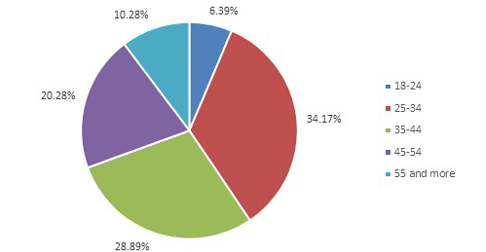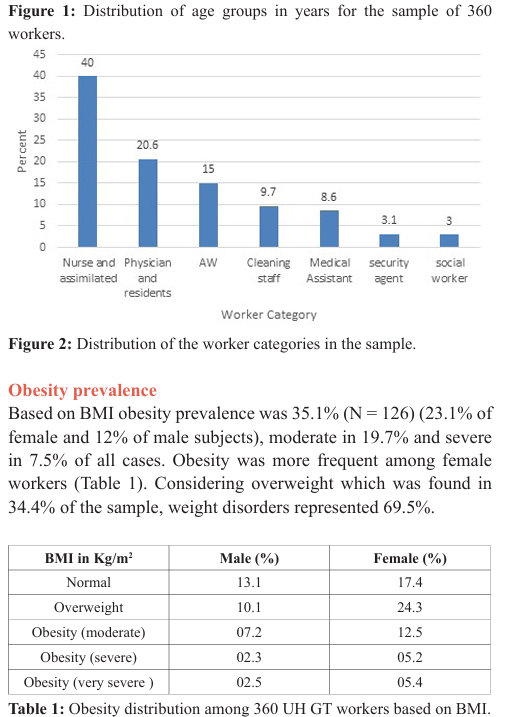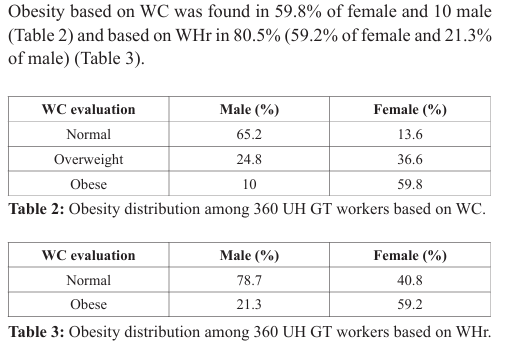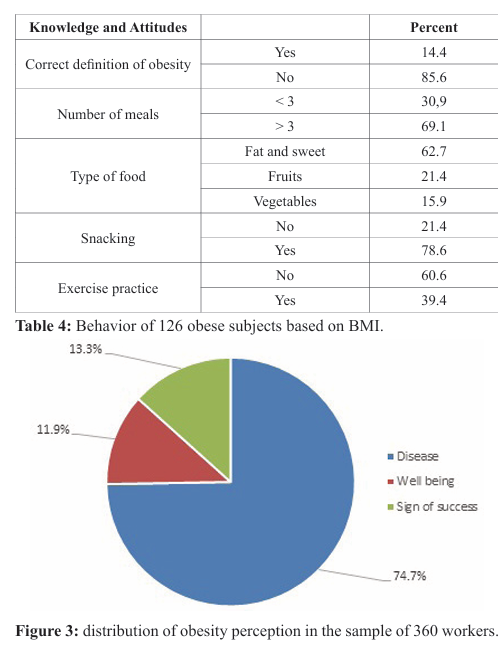Obesity and Overweight among Workers of the University Hospital Gabriel Touré (UH GT) in Bamako
Author'(s): Sangaré Ibrahima1*, Bâ Hamidou Oumar1, Camara Youssouf2, Menta Ichaka1, Sidibé Noumou1, Traoré Aladji1, Kéita Bekaye1, Sogodogo Adama1, Diall Ilo Bella3, Sangaré Lydia-Berenice SA3, Coulibaly Souleymane3, Diallo Boubakar3 and Sanogo Kassoum1
1 University Hospital Gabriel Touré, Bamako, Mali
2 University Hospital Kati, Mali
3 University Hospital Point G, Bamako, Mali
*Correspondence:
Ibrahima Sangaré, University Hospital Gabriel Touré, Bamako, Mali, E-mail: flakebus@yahoo.fr
Received: 15 October 2018; Accepted: 04 November 2018
Citation: Sangaré Ibrahima, Bâ Hamidou Oumar, Camara Youssouf, et al. Obesity and Overweight among Workers of the University Hospital Gabriel Touré (UH GT) in Bamako. Cardiol Vasc Res. 2018; 2(4): 1-3.
Abstract
Introduction: Obesity is today a real public health problem. The aim of our study was to determine its prevalence, the associated behaviors and to assess the level of knowledge among the personal of the University Hospital Gabriel Touré about this cardiovascular risk factor.
Materials and methods: It was a cross-sectional and descriptive study in July 2014 at the University Hospital Gabriel Touré in Bamako including any worker who agreed to participate. We used a formulary to collect data and evaluated Body Mass Index (BMI), waist circumference (WC) and WC-to-Hip ratio (WHr). These measures served to define and classify obesity. Data were analyzed using SPSS software version.12.
Results: The overall participation rate was 58.8% female being predominant with 53.1%. Based on BMI, obesity and overweight were found in respectively 35.1% and 34.4%. Using WC obesity prevalence was 49.8% for women and 10% for men. Applying WHr cut-off values 59.2% of women and 21.3% of men were obese. Frequently associated functional signs were joint pain (10.3%). Among the included participants 14.4% were able to define correctly obesity and 74.7% saw it as a disease. 78.6% of obese employees had an attitude of nibbler, 62.7% ate too fat and too sweet. Regular physical activity was practiced by 36.5% activity and 60.3% wanted to keep her weight as such.
Conclusion: Obesity and overweight are frequently encountered among worker of UH GT and are of raising concern. Hospital workers being crucial for sensitization to change behavior it is crucial to initiate actions in order to bring these workers to understand obesity and overweight health issues so they can adhere to obesity find program.
Keywords
Introduction
Obesity is an excess weight due to fat accumulation that may have adverse effects on health. It results from an imbalance between energy intake and expenditure. WHO defines obesity as excessive increase in fat body mass as it may affect the individuals’ health [1].
Responsible for high morbidity due to its metabolic, cardiovascular and articular effects, obesity is a major public health problem whose gravity is still underestimated in our country. It is the most common nutritional diseases in industrialized countries with one in three obese in the United States of America [1]. This same trend is now seen in developing countries, especially those considered economically emerging.
This also justifies the WHO fear which redoubts a rapid increase in obesity-related lifestyle change in these countries [2]. The prevalence of obesity in the general population was 8.8% and 14.7% respectively based on body mass index and waist circumference [3].
We conducted this study to determine the prevalence of obesity among the workers of the UH GT, to associated attitudes and to assess their level of knowledge about this pathology.
Materials and Methods
It was a cross-sectional and descriptive study that took place during July 2014 at the UH GT in Bamako. UH GT is the second reference hospital of Mali by its importance.
After getting the consent of the hospital direction, we sent a correspondence to all services explaining the objectives and how and what we want to collect for a better adhesion to the study.
Included were all actual workers willing to participate: A formulary with questions on sociodemographics, risk factors, knowledge and attitudes was used to collect data. Obesity was defined based on Body Mass Index (BMI), waist circumference (WC) and Waist to Hip ratio (WHr). BMI was calculated as Weight in Kg /Height (in m) squared. WC was measured with a nonstretchable tape over the light clothed abdomen at the narrowest point between the lowest rib and the iliac crest. Hip circumference was measured around the widest portion of the buttocks. Cut-off values were for:
- BMI: Obesity for ≥ 30 Kg/m2
- WC ≥ 88 cm for Women and ≥ 102 cm for Men
- > 0.85 for women and > 1 for men
Participation to the study was free and anonymous. After data collection and insertion into an access database, analysis was performed using SPSS software version 12.
Results
From the 612 workers, 360 with female in a proportion of 53.1% were included in the study giving an overall participation rate of 58.8%. the emergency department workers were most represented with 15.6%. the age groups 25-34 and 35-44 years were the most represented with respectively 34.17 and 28.89% (Figure 1). Nurses and assimilated were the most represented followed by Physician and residents (Figure 2).



Knowledge and attitudes
Obesity had been defined correctly by 14.4% of the sample (Table 4). A proportion of 74.7% perceived it as a disease (Figure 3).
78.6% of obese employees had an attitude of snacking, 62.7% ate too fat and too sweet. Regular physical activity was practiced by 36.5% activity and 60.3% wanted to keep her weight as such (Figure 3).

Discussion
We conducted the survey in the best conditions of mobilization and adherence to the study justify a relatively participation rate. We will be short of sufficient data for comparison since very few studies dealt with obesity and health personal.
The prevalence of obesity was 35.1% (n = 126), up 69.5% rate as we associate overweight (34.4%). These results are superior to that of ObEpi investigation [4] in Paris, which is 11.2% of moderate to severe obesity and 29.2% overweight.
Females accounted for 53.1% with a sex ratio of 1.13. This result is consistent with the ObEpi survey that found 50.2% of women [4]. This predominance of the female sex could be related to cosmopolitan factors such as menopause, sedentary lifestyle but also looking for compliance with a reference aesthetic model. In developing countries some overweight is part of the beauty standards of the general population justified by gavage, a common practice in some african socio-cultural environment. This is the case in Mauritania, Niger and northern Mali, where girls of ten years are forced to ingest large amounts of food per day. The objective is to acquire certain roundness synonymous with beauty and wealth.
Abdominal obesity (WC: > 88 in women, > 102 in men) is much lower in our series (49.8% of women and 10% of men) compared to the results obtained in the investigation ObEpi (58.6% in women and 46.2% in men). [4] Obesity of android type was more common in women (59.2%) than in men (21.3%).
Obesity (BMI ≥30) was correctly defined by 14.4% of all of our respondents and 74.7% considered it as a disease, in line with the global vision of WHO that now considers obesity as a disease listed in the list of priority for chronic conditions.
A little more than 2/3 of the obese subjects (69.1%) ate more than three main meals a day, even finding by Aboussaleh Y. et al. (53.2%) [5]. The concept of snacking was found in 78.6% and 38.1% of obese subjects have clearly shown their preference for fatty foods. Sedentary behavior was found in 63.5% of cases and the period of relaxation was significantly higher than an hour of time every day watching television, computer or video games. Regular practice of walking was found in 39.4% and the diet was adopted by 38.1% of our respondents as a way to lose weight.
Of concern is the fact that most obese subjects in the study are not willing to lost weight, making their participation to sensitization and fight against obesity conjectural.
Conclusion
Obesity and overweight are frequently encountered among worker of UH GT and are of raising concern. Hospital workers being crucial for sensitization to change behavior it is important to initiate actions in order to bring these workers to understand obesity and overweight health issues so they can adhere to obesity fight program. The latter includes changing food intake and promote exercise.
References
- Obesity: preventing and managing the global epidemic. Report of a WHO consultation on obesity. WHO, Geneva, 3-5 June1998.
- Depeuch F, Maire B. Obésité et développement des pays du sud. Med Trop 1997; 57: 380-388.
- Bâ HO et al. Surpoids et obésité dans la population au-dessus de 20 ans en milieu urbain bamakois (Mali). The Pan African Medical Journal. 2014; 19: 352.
- Enquête épidémiologique nationale sur le surpoids et l'obésité-INSERM / KANTAR HEALTH / ROCHE. 2021.
- Aboussaleh Y, Farsi M, El Hioui M, et al. Transition nutritionnelle au Maroc: Coexistence de l'anemie et de l'obesite chez les femmes au Nord-Ouest marocain. Antropo. 2009; 19: 67-74.